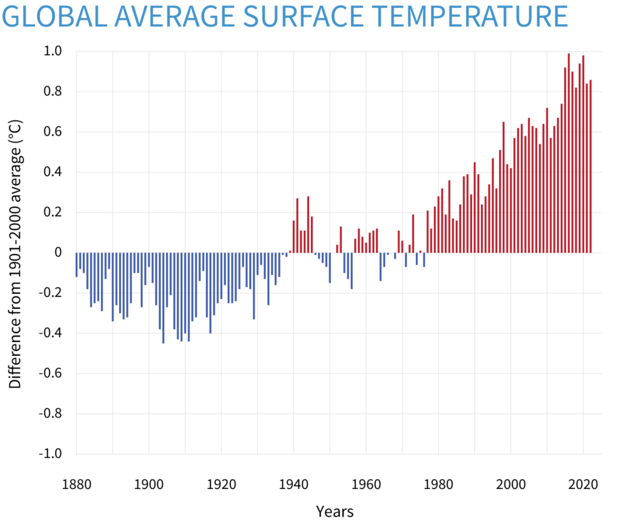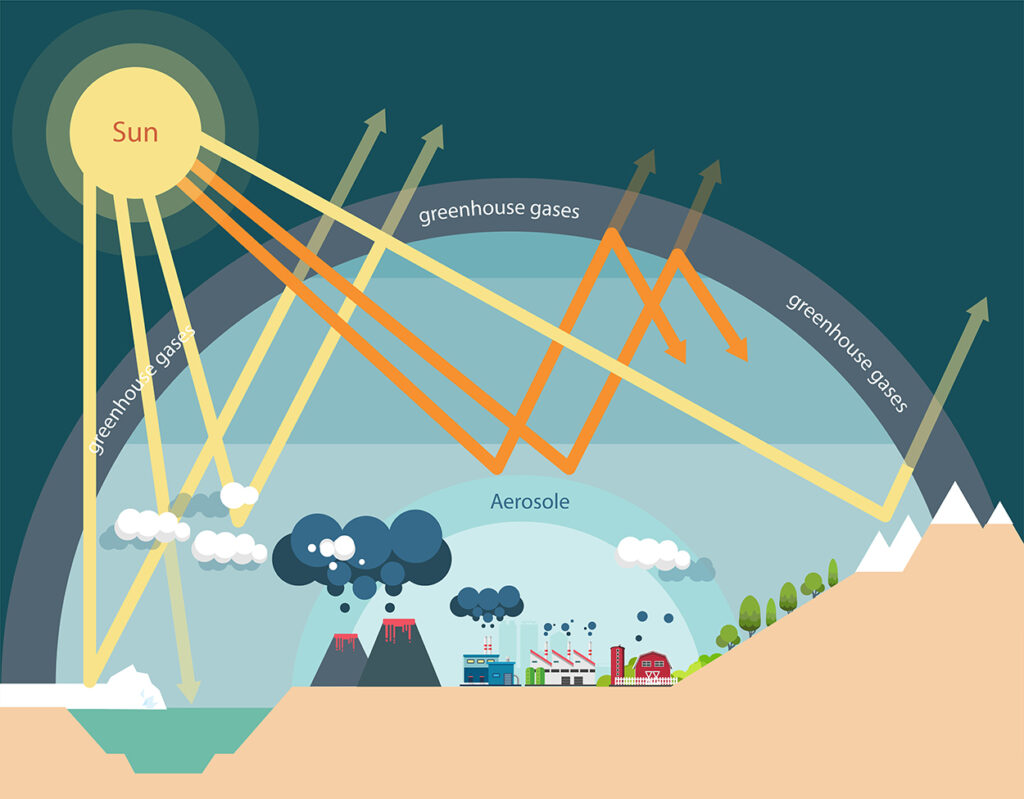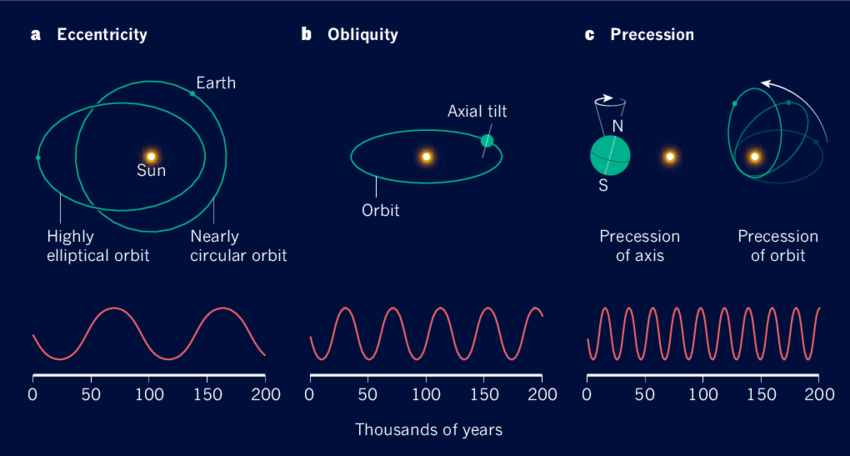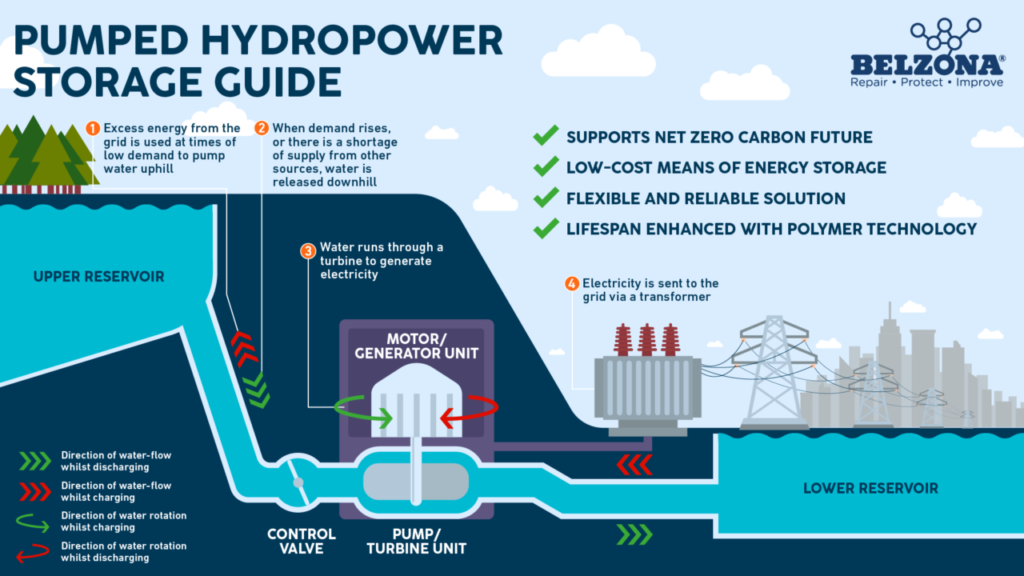There are a whole lot of words, phrases, and titles that are associated with the issue of Climate Change. Let this blog post be a dictionary or the SparkNotes you use when you come across a confusing jumble of letters relating to this massive and complex problem.
General Phrases
Climate Change
A long-term shift in weather systems, temperatures, and ecological-dependent patterns like ocean/sea currents, wind currents, geological activity, and/or atmospheric conditions.
Usually measured in decades, these long-term shifts are studied using a wide range of metrics like global average surface temperature, ocean temperature, and CO2 concentration. These metrics are used to compare historical levels through ice-core samples, tree rings, and coral reefs.
Climate change is a natural process as the Earth changes over time and systems ebb and flow through time. However, the effects we see currently are far beyond the bounds of what is natural.
Anthropogenic Climate Change
Changes to the climate effected by the systematic burning of fossil fuels. Anthropogenic is a fancy word meaning man-made (anthropo- meaning from man, -genic meaning made).
This is what almost everyone means when they say, “Climate Change,” and it is what I will mean exclusively. The natural processes of climate change do not make such drastic shifts on such small-time scales.
Hence, extreme weather, temperature increases, melting ice caps, and ocean acidification are direct consequences of anthropogenic climate change.
Global Warming
A synonym of climate change but speaks specifically of the rise in global temperature. As an outcome of the mass release of carbon-based gases, global warming is thought to be the prime issue of climate change, hence the synonymity.
Since 1880, the global average temperature (land and ocean) has risen by 2° Celsius. If we continue to release carbon-based gases at the rate we are now, the global average temperature will rise by 10.2° Celsius, compared to the 1901-1960 average. The warming has been tied, through almost every globally recognized metric, to the burning of fossil fuels that started during the Industrial Revolution.

Fossil Fuels
Materials that are organically based, or contain carbon, makeup coal, oil/petrol, and natural gas. When organic materials, like planets and animals, die and decompose, the carbon-based molecules that make up every part of their chemistry become sequestered into the Earth’s crust.
As time passes and more and more matter is piled on top, the pressure and heat become so immense that the complicated compounds are pressed into oil and/or coal. In the same way, fossils are dug up, these fuels are found by drilling deep into the Earth, as the process takes millions of years.
Industrial Revolution
Starting in the 1800s with the widespread use of the steam engine, this shift in the global economy marked the beginning of the modern era. The ability to do work was no longer chained down to what one man or one animal could do in a day.
Coupled with the widespread use of electricity, the Industrial Revolution welcomed humanity into unprecedented levels of both population growth and capital accumulation, as well as poverty. Of course, powering the steam engine required a constant need to burn things to convert water into steam.
This need led the Industrial Revolution to be closely linked with the burning of coal and the start of Global Warming.
Carbon-based gases
Most notably Carbon Dioxide (CO2), these gases are released when fossil fuels are burned. When carbon-rich materials like coal, natural gas, or oil are burned, carbon is set free into the air where it combines with oxygen gas to make CO2.
In addition, methane (CH4) is also released through various anthropogenic activities like landfills, agriculture, natural gas burning, coal mining, etc. Though methane emissions are smaller by mass than CO2, methane is a much more potent greenhouse gas.
Greenhouse effect and gases (GHGs)
The greenhouse effect is the tendency of air molecules to hold on to heat and release it back into the atmosphere. Like a greenhouse a gardener would use to keep their plants in a warmer environment, the atmosphere traps heat bouncing off the Earth’s surface, trying to escape into space, thereby increasing the temperature of the Earth.
GHGs like carbon dioxide and methane have a special molecular shape that allows them to absorb certain bands of solar radiation, which wiggles the molecule. Eventually, the energy is released in the form of radiation, in all directions, including back towards Earth, restarting the process.
Of course, the greenhouse effect is an important aspect of keeping the Earth habitable, meaning we cannot stop the effect, nor can we remove all of the GHGs from the atmosphere. Other GHGs include nitrous oxide (N2O) and water vapor (H2O).

In The Fight Against Climate Change
Paris Climate Agreement
The international treaty signed in 2015, holding the 196 countries to keep “the increase in the global average temperature to well below 2°C above pre-industrial levels” and pursue efforts “to limit the temperature increase to 1.5°C above pre-industrial levels.”
Intergovernmental Panel on Climate Change (IPCC)
An international organization set up by the World Meteorological Organization and the United Nations Environment Program. Endorsed by the United Nations, the 195 member states elect a committee of scientists to six- or seven-year assessment terms.
Though they do not conduct original research, these scientists collect and assess any available scientific publications. They distill this information into climate reports that are widely shared and corroborated. Since its creation in 1988, it has released a report almost every year, with its most notable release being its Fifth Assessment Report, a document of crucial influence on the Paris Climate Agreement.
Renewable Energy
A method of energy generation that harnesses a passive form of energy transfer. Since it is passive, it does not require any burning of fossil fuels. If we want to transfer our energy systems away from fossil fuels, renewables are the best chance we have.
The only issue is that renewables are not necessarily constant—there are gaps in which even a diverse grid of renewables may have gaps in electricity generation. Luckily, in the times in which renewables are most effective, there is a surplus of energy. By using energy storage like batteries, renewables can cover the demand for electricity on a daily basis without disruption.
Carbon Neutral
The goal most global committees agree to be at by 2050. The broad plan calls for the phasing out of fossil fuels and the implementation of renewable energy generation. Also called Net Zero Carbon, the continuation of neutral carbon emissions requires a balance of carbon emitted and carbon absorbed. This means that as long as we can offset the emitted carbon by scrubbing it from the atmosphere, we can continue to pollute the Earth.
Carbon Sinks
Both technological and natural, carbon sinks are large attractors where carbon can be collected and/or sequestered. Natural carbon sinks are the ocean and forests, and they represent the most reliable methods of removing carbon from the atmosphere. Technological carbon sinks, called Carbon Capture, are devices that pull in large amounts of air, extract carbon dioxide and inject it deep underground.
Milankovitch Cycles
The long-term cycles of the Earth in which the distance to the Sun varies only slightly, however, it results in large changes to the climate. Additionally, the Serbian geophysicist, Milutin Milankovitch, who hypothesized these cycles also cited the Earth’s axial tilt variation, axial precession, and orbital precession as other contributing factors.
Typically brought up by climate deniers, it is an excuse to say that anthropogenic climate change is not an important issue and that the warming we measure is due to one of the factors cited by Milankovitch. That is not correct.
We actually already got close enough to the Sun to see the effects about 6,000 years ago. By this model, we are supposed to be heading toward an ice age in about 30,000 years.
Looking at the global average surface temperature, we should see it starting to lower. However, it is clear that the temperature is rising far beyond what any recent Milankovitch cycle would result in. Comparing the temperature to the CO2 emissions, there is an almost direct connection. Supporting the fact that fossil fuel burning is taking us away from any natural climate cycle.

Alternative Power Generation and Storage
Nuclear Power
The most complicated way to boil water. Nuclear fission power is the harnessing of the process by which large, unstable atomic nuclei split and release massive amounts of energy.
Developed in the mid-20th century, this technology keeps uranium-rich rods submerged in a bath, surrounded by control rods. In the process of nuclear decay, uranium-235 atoms split into two smaller nuclei and a rouge neutron, a subatomic particle. The rouge neutron collides with a neighboring uranium nucleus and triggers another split.
The control rods are made of a material that acts as a neutron sink, absorbing neutrons and slowing the process. Without them, you would have a nuclear bomb or the events of Chernobyl. The energy release heats water and converts it into steam, turning a turbine and creating electricity.
Hailed as the safest form of energy generation, having significantly fewer deaths per megawatt of electricity generated even compared to renewable energy, nuclear power is still stained from past incidents like Three Mile Island (1979, 0 reported deaths), Fukushima (2011, 0 reported deaths), and Chernobyl (1986, approx. 59 deaths).
Solar Energy
Harnessing energy from the Sun, this renewable energy generator uses solar panels pointed at the Sun to create electricity.
Due to the photoelectric effect discovered by Albert Einstein, a photon (a packet of light energy) interacts with molecules suspended in the panel. Photons of the right energy quite literally kick electrons from orbiting molecules. The free electrons then have space to move to an electrically attractive layer in the panel, creating a current for electricity.
The scientific discipline of photovoltaics is charged with studying this effect. These scientists test different materials to find higher efficiencies; most solar panels sit around 30% efficiency, meaning that they convert 30% of the sun’s energy into electricity. However, new discoveries are made every year which raise the standard efficiency.
Solar panels have been gaining popularity with homeowners and landlords as they install panels on the roofs of houses and buildings. The energy generated is sold by the owners back into the grid, increasing the amount of electricity available and almost entirely cutting the owner’s energy bill.
Wind Energy
A renewable that hooks a turbine up to giant fans in prime locations for wind gusts to turn the blades. The locations of wind turbines vary in their aid to efficiency, but the common placements are at the base of mountains/hills, offshore, and in the middle of large plains. Similar to solar panels, wind turbines top out at around 30% efficiency, bounded by the engineering principles of turbines.
Hydroelectric Energy
Dams or plants are built across large rivers to create a build-up of water which is flowed over turbines, spinning them quickly. The spinning turbine generates electricity which is sent through transmission lines to the grid and then to consumers. Though it has been one of the most reliable renewables, climate change may alter water patterns and make it difficult for dams to have enough water to generate a usable amount of energy.
Geothermal Energy
This renewable uses the heat from the Earth’s mantle to boil water for a steam engine. Digging deep, through the Earth’s crust and laying down reliable piping for this is difficult and expensive in most areas. However, in Iceland, where volcanic activity creates thermal vents, it is the country’s dominant energy generator. Having this be a widespread generator will be difficult due to its need for deep drilling in the absence of reliable thermal vents.
Pumped Hydro Energy Storage
This method of energy storage uses surplus energy in a grid to pump water up a hill from a lower reservoir into a higher reservoir. By letting the water fall back down, it uses hydroelectric power to generate electricity to gain back the energy used to pump it up.
Depending on the time of day, the cost of electricity will fluctuate in conjunction with the demand for it in the grid. By timing it right, there is little to no loss of power transferring water between the upper and lower reservoir. The downside of pumped hydro is that it is not geographically convenient—finding locations where it’s possible to make two large freshwater reservoirs that are horizontally close but vertically far is difficult, especially in smaller countries.
A possible alternative, instead of using gravity, is to pump water into a pressurized container, allowing the pressure to push the water back out.

To be continued…
If you are interested in learning what this blog is about, read my first blog post. If you want to learn some shocking facts about climate change, click here.


One response to “What is Climate Change Anyways? Let’s Start a Glossary.”
[…] To see how I define some important definitions, read my glossary. […]